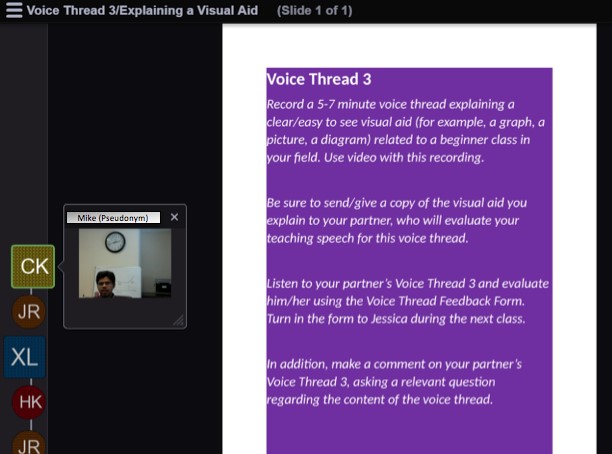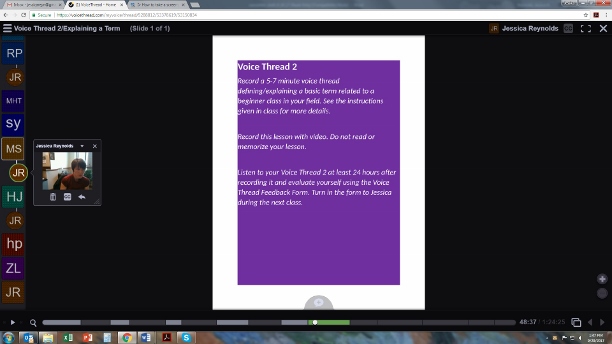|

Taewoong Kim
|
|

Jessica Reynolds
|
[NOTE: This article has not been copyedited due to its length.]
“The more you speak out, regardless of mistakes, the better you
will speak.” As language teachers, we know that this “use it, or lose
it” approach is paramount for building a robust fluency in any language
skill. For ITAs, however, their language use context is far more
high-stakes, and their affective filter (Krashen, 1989) is more
difficult to overcome than that of a typical language learner,
especially for ITAs who will be instructors of record. What this means
is that ITAs may feel more apprehensive about “speaking out,” becoming
disheartened and demotivated by their mistakes, due to the pressures
involved in their spoken English performance. Consequently, ITA trainers
must present multiple platforms for individual learners to practice,
receive feedback and gain confidence in using teaching speech.
Participation & Feedback Issues in Teaching Speech Simulations
There are several constraints that challenge ITA trainers in
their capacity to provide appropriate avenues for teaching speech
practice:
-
Time and class size: Teaching simulation
exercises are hallmark activities for ITA workshops and training courses
since they reflect the target language use context and output (Gorsuch,
Meyers, Pickering & Griffee, 2013; Madden & Myers,
1994; Schmidgall, 2012; Smith, Meyers & Burkhalter, 2007).
However, class sizes and time constraints can logistically prevent ITA
trainers from including many teaching simulation exercises within the
course duration and from providing subsequent, individualized feedback.
This means frequent, quality formative assessment, although essential
for learning, is often infeasible (Richard-Amato, 1988).
-
Trainees’ affective filters: The urgency
of improvement for many ITAs can acutely raise their affective filters,
limiting output, reducing participation and even causing fear of
teaching simulation exercises and feedback. Therefore, the teaching
speech practice activity must be scaffolded (i.e., Zone of Proximal
Development) for trainees who lack speaking confidence and/or ability to
produce fluent spoken English for the target language use context
(Vygotsky, 1978).
-
Limited reflection opportunities: Teaching
simulation exercises in class are less likely to facilitate the
critical reflective process, a metacognitive tool for monitoring
outcomes and corresponding thought processes for language acquisition
(Coutinho, 2007; Flavell, 1979; Rubin, 1981; Swain, 2005). During class,
with peers present, learners may be more reluctant to critically notice
their speech’s features, or be overly attentive to every small mistake,
causing demotivation, over-compensation, and disfluency. Excluding
these extremes, the restriction of time that an in-class teaching
simulation exercise presents can inhibit the process of reflection from
moving beyond the cursory and obvious.
-
Lack of peer-peer interaction: A
perennially difficult aspect of managing any course is facilitating
quality peer-peer interaction, while maintaining as authentic a language
use situation as possible. Teaching simulation exercises tend to
produce teacher-dominated feedback, due to peer reluctance to share in a
large group, lack of peer feedback training/experience and/or peer
inattention from long periods of listening. Nonetheless, gaining
knowledge from the teacher only is both wasteful and authoritarian
(Gatbonton, 2008; Richard-Amato, 1988).
-
Loss of speaking equity: Equal access to
trainees’ output can be lost in classroom exercises, as some learners
are more prepared to speak up than others, giving talkative learners
more of the teacher’s attention and feedback. This lack of speaking
equity can impact learner identity concerns (Norton, 1997).
-
Complexity of similar tools: While still
useful, similar web-based tools present an unwieldy number of features,
many of which are unnecessary for ITA training purposes (e.g., EdPuzzle,
Kaizena, PlayPosit). We have found VoiceThread to be one of the most
directly useful tools for achieving the learning goals of the ITA
training class, while also mitigating the issues listed here.
-
Limited spoken feedback options: Most
web-based tools are more conducive for providing written feedback than
spoken feedback. For teaching speech, spoken feedback is essential
because it supplies both modeling and listening discrimination input
that are crucial for ITAs’ uptake of prosodic features (pausing, pitch,
and word stress patterns), accurate sound articulation, and fluency
(Gilbert, 2008; Hahn, 2004; Trofimovich & Baker, 2006;
Wennerstrom, 2000).
Suggested Solution: Using Voicethread as an Ita Training Tool
VoiceThread, a web 2.0 application, is a tool we have
successfully used for ITA training and English for Academic Purposes
(EAP) learners’ speaking skills enhancement. This tool mitigates the
aforementioned constraints and is extremely user-friendly. Specific
features of VoiceThread that render it useful in the ITA training
context are as follows.
-
Video comments can be recorded by learners and teachers.
Recordings are made on any device with a camera, meaning ITAs can make
teaching speech samples at their convenience on their
smartphones/tablets/laptops, in settings that are more comfortable for
them outside of class, or in more private settings during class (see
Figure 1). We have had learners bring headphones and record in class; a
language lab with headphones and computers could also allow for in-class
recordings. The teacher can also provide in-depth comments, pinpointing
particular features of the learner’s speech, modeling sound
articulation and prosodic cues.
-
ITAs can even record in-class teaching simulation exercises
for self-reflection and teacher feedback later. We have experimented
with this and found that individuals with iPhones, Android devices and
laptops/tablets can record themselves “teaching” during the training
class, upload their recordings to VoiceThread, self-evaluate, and
receive individualized teacher feedback (see Figure 2).
-
VoiceThread allows ITAs to be removed from an “audience”
which can lower their affective filter, especially in the first few
teaching speech activities. Allowing ITAs to acclimate to hearing their
voice and self-evaluating early on in the training course abbreviates
the nervousness and awkwardness felt when speaking in front of an
audience. In short, VoiceThread can serve as a scaffolding tool to boost
learners’ poise and fluency in their teaching speech before presenting
to a live audience.
-
ITAs gain equal access to the teacher feedback because
comments can be made on individual learners’ recordings, as well as time
for critical self-reflection, via the remotely accessible e-oral
feedback. While the remote aspect of VoiceThread may seem to promote
decontextualized, non-interactive language use, in fact, the threaded
commenting and “groups” functions enhance peer-peer interaction and
collaboration beyond what would be possible in a classroom
setting.

Figure 1. Trainee's Micro-Teaching Video Example
Click to enlarge

Figure 2. Trainer's Video Feedback Example
Click to enlarge
Ita Trainees’ Feedback About Voicethread
Informal course feedback collected from our ITA training
classes revealed nearly all trainees (all names below are pseudonyms)
found VoiceThread useful for their teaching speech improvement. For
example, Rajmohan appreciated the self-monitoring and peer-learning
afforded by VoiceThread:
I can hear other people's voice records and do my record at
home which is very convenient. VoiceThread makes me hear my own voice
first time and find my shortcoming. It helps me a lot because I had
never heard my own voice before since I thought it is weird (Survey
answer, September 7, 2017).
Similarly, Guo described VoiceThread as:
Easy to record. I can go back and listen how I speak. I can
also listen how other people speak and to learn from them (Survey
answer, September 7, 2017).
This option of re-accessing recordings was strongly welcomed by trainees, as another ITA mentioned:
With VoiceThread, I can record and listen to my record.
Sometimes when I am speaking, I cannot notice all that I have to work
with. I found myself speaking monotone all the time when I speak
spontaneously, which will not happen when I read a paragraph (Maria,
Survey answer, September 7, 2017).
Moreover, Michael insisted, “The most helpful thing is the
teacher can comment on our assignment and give feedback. Also we can
repeat it” (Survey answer, September 9, 2017). Overall, learners
highlighted self-evaluation, teacher and peer feedback, and re-recording as VoiceThread’s primary
benefits.
Example Voicethread Tasks for Ita Training Courses
We have used this dynamic tool extensively over the last two
years, for over 300 students, both ITAs-in-training and EAP students.
Example activities used are listed below.
-
Read a text (usually an excerpt from a university lecture)
aloud to practice prosodic cues // Teacher comments
-
Discuss class topics in more detail // Peers comments
-
Reflect on teaching speech features from a previous
VoiceThread or in-class activity // Self-evaluation comments
-
Upload a micro-teaching lesson with video // Teacher, peer and self-evaluation comments
-
After receiving feedback, re-record the teaching speech
assignment, paying attention to improvement in the feedback
areas
Limitations
Despite the advantages above, several limitations exist when
using VoiceThread in practice, regarding cost, technology issues, and
privacy. Leaving comments and answers are free for an unlimited number
of learners. However, creation of VoiceThreads is
limited to five for a free account; after that, users must purchase a
license (See https://voicethread.com/products/highered).
The technology problems usually are with the phone app freezing or
logging a learner off. This is infrequent, in our experience, and
learners typically encounter this when they are signed in on multiple
devices. Also, we have found that long video comments can take a few
minutes to load. For privacy, learners may feel intimidated sharing
videos or recordings which peers can watch/hear. Jason, an ITA,
recounted, “There is no choice in VoiceThread for us to set some
recordings as private, if we do not want others to watch it” (Survey
answer, September 10, 2017). While there are ways to create a
VoiceThread so that learners share recordings only with the teacher,
extremely shy learners may still experience a raised affective filter
when using VoiceThread.
Implications
The primary usefulness of VoiceThread for ITAs resides in the
metacognitive connection (Flavell, 1979), that enables them to monitor,
reflect, re-use, and internalize target L2 features. As VoiceThread
enables a direct speaking activity, learning
by doing is likely to be achieved (Dewey, 1903). The
e-interactions between peer-peer and learner-teacher are another
advantage, given that interaction is an essential aspect of second
language acquisition (Long, 1996). Furthermore, ITAs have indicated
their appreciation of presenting remotely, which reduces
nervousness.
Returning to the mantra of “use it or lose it,” VoiceThread can
initiate ITAs to use spoken English, to keep
learning and improving their teaching speech, and thus to gain
confidence for their real-world performance. Nonetheless, using this one
digital platform is not a panacea; rather, quality teacher feedback,
positive dynamics with peers, and self-awareness in learning, are all
behind the scenes of any successful tool. We encourage ITA trainers to
consider using VoiceThread in their contexts to enhance the confidence
and capacity of ITAs in training.
References
Coutinho, S. A. (2007). The relationship between goals, metacognition, and academic success. Educate, 7 (1), 39-47.
Dewey, J. (1903). Democracy in education. The
Elementary School Teacher, 4(4),
193-204.
Flavell, J. H. (1979). Metacognition and cognitive monitoring: A new area of cognitive–developmental inquiry. American psychologist, 34(10), 906-911
Gatbonton, E. (2008). Looking beyond teachers' classroom behaviour: Novice and experienced ESL teachers' pedagogical knowledge. Language Teaching
Research, 12(2), 161-182.
Gilbert, J.B. (2008). Teaching pronunciation using the
prosody pyramid. Cambridge: Cambridge University Press.
Gorsuch, G., Meyers, C.M., Pickering, L., & Griffee,
D.T. (2012). English Communication for Teaching Assistants (2nd Ed.). Long Grove, IL.: Waveland Press.
Hahn, L. D. (2004). Primary Stress and Intelligibility: Research to Motivate the Teaching of Suprasegmentals. TESOL Quarterly, 38(2), 201-223.
Krashen, S. (1989). We acquire vocabulary and spelling by
reading: Additional evidence for the input hypothesis. The
modern language journal, 73(4),
440-464..
Long, M., H. (1996). The role of the linguistic environment in
second language acquisition. In W. Ritchie & T. Bhatia (Eds.), Handbook of second language acquisition (pp.
413-468). New York: Academic Press.
Madden, C. G., & Myers, C.L. (Eds.) (1994). Discourse and performance of international teaching assistants. Alexandria, VA.: TESOL.
Norton, B. (1997). Language, identity, and the ownership of
English. TESOL quarterly, 31(3), 409-429.
Richard-Amato, P. A. (1988). Making It Happen: Interaction in
the Second Language Classroom, From Theory to Practice. Longman Inc., 95
Church St., White Plains, NY 10601-1505..
Rubin, J. (1981). Study of cognitive processes in second
language learning. Applied Linguistics, 11,
117-131.
Schmidgall, J. E. (2012). Using an ITA assessment to provide detailed feedback on performance: Implications for learners, teachers, and validity. Paper
presented at the Language Testing Research Colloquium, Princeton, NJ.
Smith, J.A., Meyers, C.M., & Burkhalter, A.J.
(2007). Communicate: Strategies for International Teaching Assistants. Long Grove, IL: Waveland Press.
Swain, M. (2005). The output hypothesis: Theory and research. Handbook of research in second language teaching and
learning, 1, 471-483.
Trofimovich, P. & Baker, W. (2006). Learning second-language suprasegmentals: effect of L2 experience on prosody and fluency characteristics of L2 speech. Studies in Second Language Acquisition, 28, 1-30.
Wennerstrom, A. (2000). The role of intonation in second language fluency. In H. Riggenbach (Ed.). Perspectives on fluency (pp. 102-127). Ann Arbor, MI: The University of Michigan Press.
Vygotsky, L. (1978). Interaction between learning and
development. Readings on the development of children,23(3), 34-41.
Taewoong Kim is a Ph.D. candidate majoring in
Instructional Leadership and Academic Curriculum at the University of
Oklahoma. Based on his 6-year ESL teaching career and an M.A. TESOL
earned at Oklahoma City University, his research interests include
technology application for language learning, social justice through
ELT, metacognition, self-efficacy, and learner identity
Jessica Reynolds is the Director of English Training
and Certification Services, a Graduate College program for international
graduate instructors at the University of Oklahoma. With 10 years of
ESL teaching experience in various countries and an M.A. in Applied
Linguistics from the University of Queensland in Australia, Jessica’s
current interests include academic rhetoric/genre writing,
learner-centered technologies that enhance interaction, English language
testing and internationalizing campuses through collaborative,
data-driven initiatives. |

